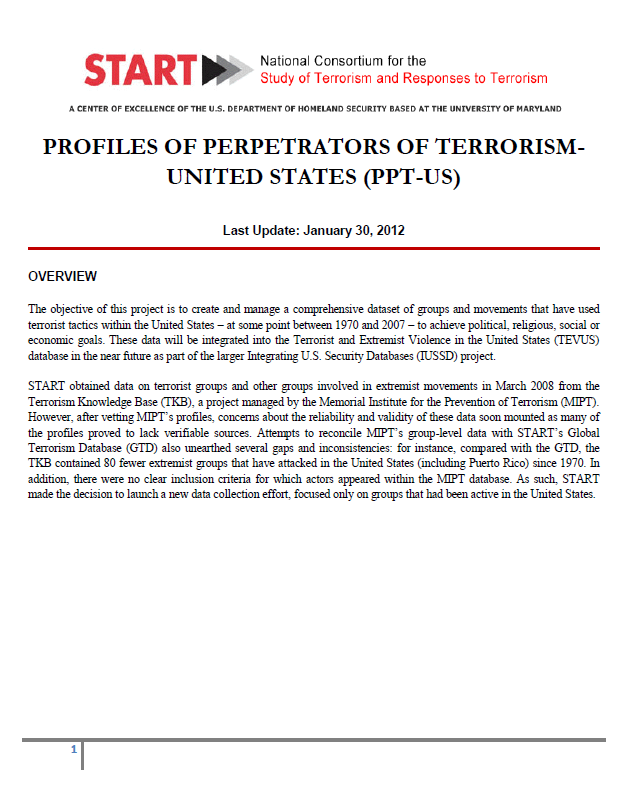DEPARTMENT OF HOMELAND SECURITY STUDY- PROFILES OF PERPETRATORS OF TERRORISM- UNITED STATES
In case you didn't believe that Big Brother is watching us, or in this case, Big Sis, here is just one of their case studies in profiling (oops, thought we weren't supposed to do that?). Below you can click to see and read the actual PDF. If you want commentary of radical Islam, sorry, they don't mention radical Islam, but you can bet your bottom dollar they do mention "right-wing". -W.E.
PublicIntel


PublicIntel
DHS-University of Maryland Study: Profiles of Perpetrators of Terrorism – United States (PPT-US)
The following project report was produced by the University of Maryland’s research program with the Department of Homeland Security called the National Consortium for the Study of Terrorism and Responses to Terrorism (START). The Profiles of Perpetrators of Terrorism – United States (PPT-US) project concerns an effort to create a “comprehensive dataset of groups and movements that have used terrorist tactics within the United States – at some point between 1970 and 2007 – to achieve political, religious, social or economic goals.” The project produced a report from the dataset earlier this year titled “Hot Spots of Terrorism and Other Crimes in the United States 1970 to 2008” that has been criticized for its identification of overly-broad psychological traits as being associated with terrorism or terrorists who have acted inside the U.S. For example, the report contains a section stating that being “fiercely nationalistic”, “suspicious of centralized federal authority”, “reverent of individual liberty” and believing in conspiracy theories are all traits that belong to “Extreme Right-wing” terrorists. According to the report, the following project was the source for defining these “ideological motivators” of specific terrorist groups.

National Consortium for the Study of Terrorism and Responses to Terrorism: A Department of Homeland Security Science and Technology Center of Excellence
- 53 pages
- January 30, 2012
The objective of this project is to create and manage a comprehensive dataset of groups and movements that have used terrorist tactics within the United States – at some point between 1970 and 2007 – to achieve political, religious, social or economic goals. These data will be integrated into the Terrorist and Extremist Violence in the United States (TEVUS) database in the near future as part of the larger Integrating U.S. Security Databases (IUSSD) project.See more
START obtained data on terrorist groups and other groups involved in extremist movements in March 2008 from the Terrorism Knowledge Base (TKB), a project managed by the Memorial Institute for the Prevention of Terrorism (MIPT). However, after vetting MIPT’s profiles, concerns about the reliability and validity of these data soon mounted as many of the profiles proved to lack verifiable sources. Attempts to reconcile MIPT’s group-level data with START’s Global Terrorism Database (GTD) also unearthed several gaps and inconsistencies: for instance, compared with the GTD, the TKB contained 80 fewer extremist groups that have attacked in the United States (including Puerto Rico) since 1970. In addition, there were no clear inclusion criteria for which actors appeared within the MIPT database. As such, START made the decision to launch a new data collection effort, focused only on groups that had been active in the United States.
…
A group or movement is included in the PPT-US if it is identified in the Global Terrorism Database as having launched at least one terrorist attack against targets within the United States homeland. PPT-US only includes groups that have at least one incident for which there is no reservation, in the eyes of GTD analysts, that the incident in question is truly terrorism (as opposed to non-terrorist violence or crime) and for which there is high confidence that the accused group is in fact responsible for the attack.
